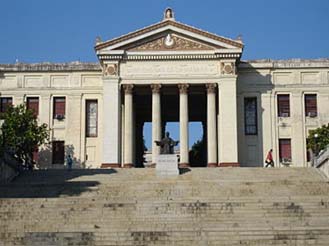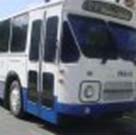|
|
|
Network Learning
|
The Educational System in Cuba is considered one of the best in the world according to UNICEF. According to UNICEF the adult (age 25+) literacy level is 99.8% and youth (age 15-24) literacy is 100% 1.

Cuba's educational system begins with primary education which lasts 6 years and two sections of secondary education. First section is basic secondary which lasts two years and is mandatory. After basic secondary is completed students can choose between pre-university education and technical or professional education for its second section. Primary and secondary education is free to all Cuban residence. Cuba offers a higher educational system after secondary is completed, these are also known as universities2.
University of Havana is the first University opened in Cuba in 1728. Currently, the university has 6,000 students distributed in its 16 facilities and 14 research centers 3. In the 1970-1971 school year University of Havana introduced a degree in Cybernetics, which included curriculum for computing.

Figure 1 - Entrance to University of Havana
Cuba's focus on literacy came at the end of the Cuban Revolution in 1959. The new government's goal was to combat the 25% illiteracy rate in Cuba. To fight illiteracy the government implemented the following programs:
Built educational brigades who where responsible for teaching people in rural areas of Cuba how to read and write.
Created new groups within the workplace to help employees learn how to read and write.
Formed night schools where people could learn how to read and write.
Cuba's fight against illiteracy worked for the illiteracy rate was decreased to 1.9% in 1961.
After the revolution 25,000 new schools were built in rural and remote areas of Cuba. For the very first time in Cuba's history, education was available to all children in Cuba, even those in rural areas4.
Cuba places a very high standard on education; it is a key in their core values.
Access to Information and Communication Technologies in School (Stage 2)
Cuba's government has been promoting education in a variety of mediums since the revolution. In the 1960's it promoted non-formal education through the use of radio. They also use television as a learning tool to educate their people across the island. In 2000 Cuba aired a show titled, "University for All" and it offered courses in English, Spanish and other topics5. Purpose of these mediums is to promote education throughout Cuba.
About 95% of the electricity in Cuban schools is provided from the electrical grid; the other 5% have electricity provided by solar panels. There are approximately 2,368 schools with solar panels, 93 of these schools have only one student. Students are taught by a several technologies; televisions, VCRS and Computers. The combination of solar panels and technologies promotes education in rural areas and hard-to-reach mountainous areas, thus reducing the technology gap between cities and rural areas.
According to official figures, more than 46,000 computers have been installed, covering all educational levels and all schools in the country. In addition, 12,800 computers were distributed to Cuba's universities. Elementary and secondary schools have a ratio of 20 students to 1 computer6 . Due to the US Trade Embargo and Cuba's economy the computers are older models, sometimes pieced together. Internet and email access is limited in the primary and secondary schools.
In some cases, computer software is used to teach high school students. The Ministry of Education (MINED) has a network of 16 education software research centers (InstEd) underneath which built a collection of CD-ROMs for teaching in Cuban High Schools. This software allows high school students to connect to RIMED (the education ministry's national information network). The software provides university prep techniques and assistance for vocational orientation.
InstEd developed a software program, El Navegante collection, which is used for teaching junior high school students. El Navegante can be found in all junior high schools in Cuba7 .
Cuba is at Stage 2 in Information and Communication Technologies in School for their computers are outdated and the ratio between student and computers is extremely low.
Enhancing Education with Information and Communication Technologies (Stage 2)
According to Fidel Castro, "Computer sciences are to become a powerful scientific, economic and political force for Cuba.8 " *
ICT education in Cuba is being promoted through the Computer and Electronics Club for Young People (JCCE's). This program was formed in 1987 for the purpose to help the computerization of Cuban society. Their goal is to make new technologies available to everyone. They aspire to facilitate Cuba's technology advancement in order to move forward and successfully compete in the global market.
Currently, there are over 600 programs located across Cuba and there are two clubs. These clubs employ approximately 5,700 people. There are five mobile computer labs which are used to service remote, rural areas of Cuba. There are 5 computer club headquarters. The club possesses about 7, 138 computers, one club for every 18,763 inhabitants. Since its inception there over 1 million people have participated in these programs courses and there are about 1 million services offered each month9 .
The youth clubs offer training in topics such as computing, electronics and communications. Certified courses can vary from 10 to 120 hours. Topics are in relation to work and operations in computers, design tools, programming, database management (both proprietary platform an open source). There are also topics related to networks; such as email, basic electronics, digital and microcomputer architecture. Delivery methods include classroom, semi-face and distance and virtual learning which is provided by the network.
Youth club personalizes it services to meet the needs of the various students; youth, adults, seniors, persons with disabilities, housewives and workers10.
The computer youth clubs have access to email and government accessed internet sites. It's estimated that 31 percent of the Cuban population has access to computers which consists of 2.5 million students, over 200,000 people at your clubs and 800,000 workers. 11

Figure 2 - Inside Mobile Youth Club

Figure 3 - Inside Mobile Youth Club
Cuba provides programs to teach people of all age's computer skills through the Youth Clubs thus enhancing education with ICT. Finding information on ICT training for educators in order for them to incorporate it within the classroom was scarce, thus I am inclined to believe there is limited ICT training in primary and secondary education. There is ICT training in higher education. In summary, Cuba is in stage 2 for enhancing education in ICT because of the availability of computers in the schools and incorporating use of computers in schools.
Developing the Information and Communication Technologies Workforce (Stage 3)
There are a total of eight Universities in Cuba which offer degrees in information technology. Cuba's information technology sector has been growing since 1991. Cuba has about 45,000 skilled IT workers, 38% of them have specialized degrees in IT. Over 85% of the IT sector is concentrated in technical services and software development. The computer science graduates from University of Havana and University of Computer Information are part of the contributing factors to this growing sector12 .
The Cuban Ministry of Higher Education introduced Distance Learning in 1979. There are a total of 15 centers in Cuba for distance learning, five of which are offered at he University of Havana. Distance education provides a degree in Scientific & Technological Information. These classes are offered either during the day, evening and weekends to workers. In order to participate in this program one must have completed secondary education, have at least one year's work experience, age between 25 -35 years old and pass an entrance exam. Currently there are about 20,000 students enrolled in the distance education program.13
In 2002 Cuba took another step in developing information and communication technologies by forming the University of Computer Information (UCI). The goal of UCI was twofold; first to train and education professionals committed to their homeland and qualified in the Computer Science field, second to produce software and information services from the study-work relations as the educational model.
UCI has over 15,000 workstations available to their students and 120 computer labs located in the on campus residential apartments. UCI has a computer network and offers a cable television network covering all classrooms. UCI offers over 20 subjects on 11 broadcasted channels .14
UCI has helped with the computerization process of the national sectors such as health & education. It has also played a major role for the Cuban Software Industry in the international market. Over 60% of the students at UCI are working on more than 150 production project and software on behalf of Cuban society and other countries in fields such as education, health, sport, government online, Free Software, websites and portals, multimedia and more.
Cuba is working on building their infrastructure in order to build a network of all its science and technology institutions. Goal of the project is to integrate over 6,000 primary and middle school libraries, 300 university libraries and more than 200 scientific institutions15. Internet Access as wells as access to local data networks and intranets are available at all the Universities in Cuba16.
Overall, Cuba is continuing to advance itself in developing a workforce for ICT. Cuba is moving to make themselves a software engineering and development center. To meet these initiatives Cuba is building its infrastructure, networks and ICT education. All people of Cuba have access to learn ICT through Universities and youth clubs. Cuba currently is at stage 3 for developing the ICT Workforce for they are offering ICT training in Universities and youth clubs to all individuals.
Recommendation
Cuba's government continues to invest and promote education. Cuba's government has been promoting ICT Learning since 1991 and they are making the steps to educate their people in ICT through University programs and Youth Clubs. However, there are obstacles Cuba faces as it tries to promote ICT. One obstacle is the poor infrastructure and network in Cuba limits the availability of information to the Cuban people. The other obstacle is the high costs of computers and limited access to the internet for its citizens. This limits the use of computers at home. It is recommended that Cuba continues to educate its people on ICT. Cuba to promoting ICT learning within schools and workplace is necessary in order for them to compete in the 21st century.
|
|